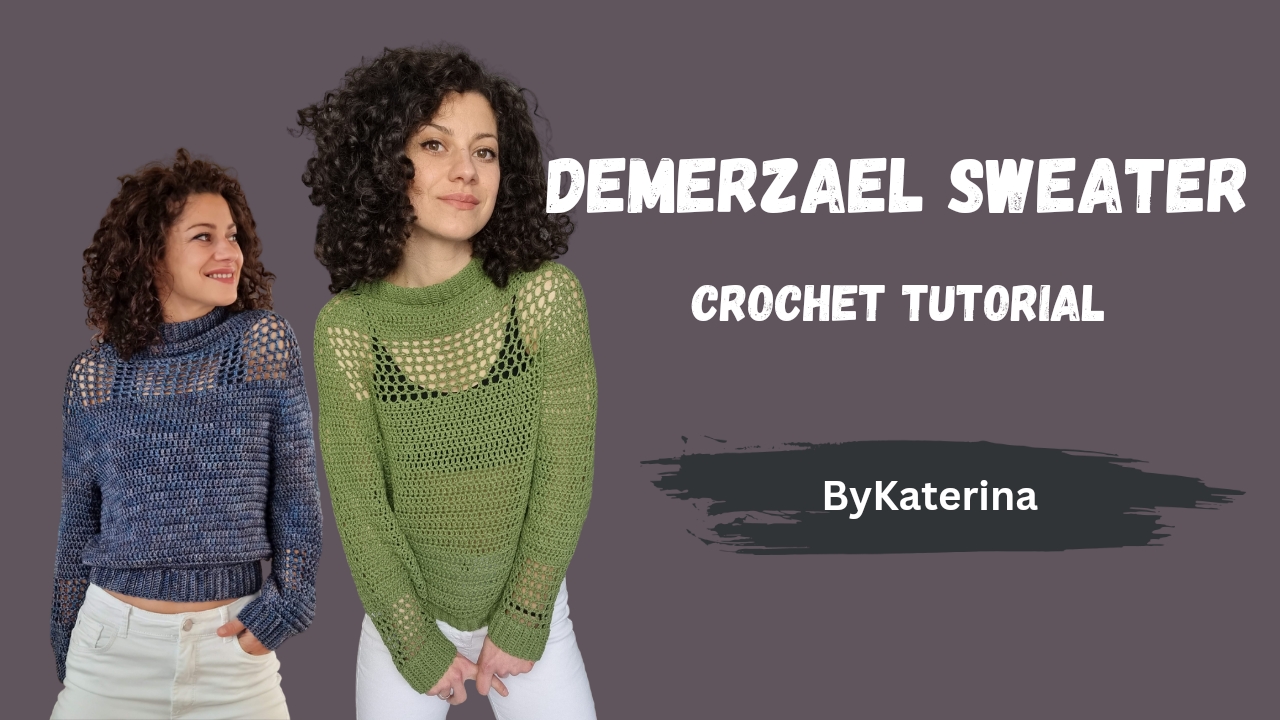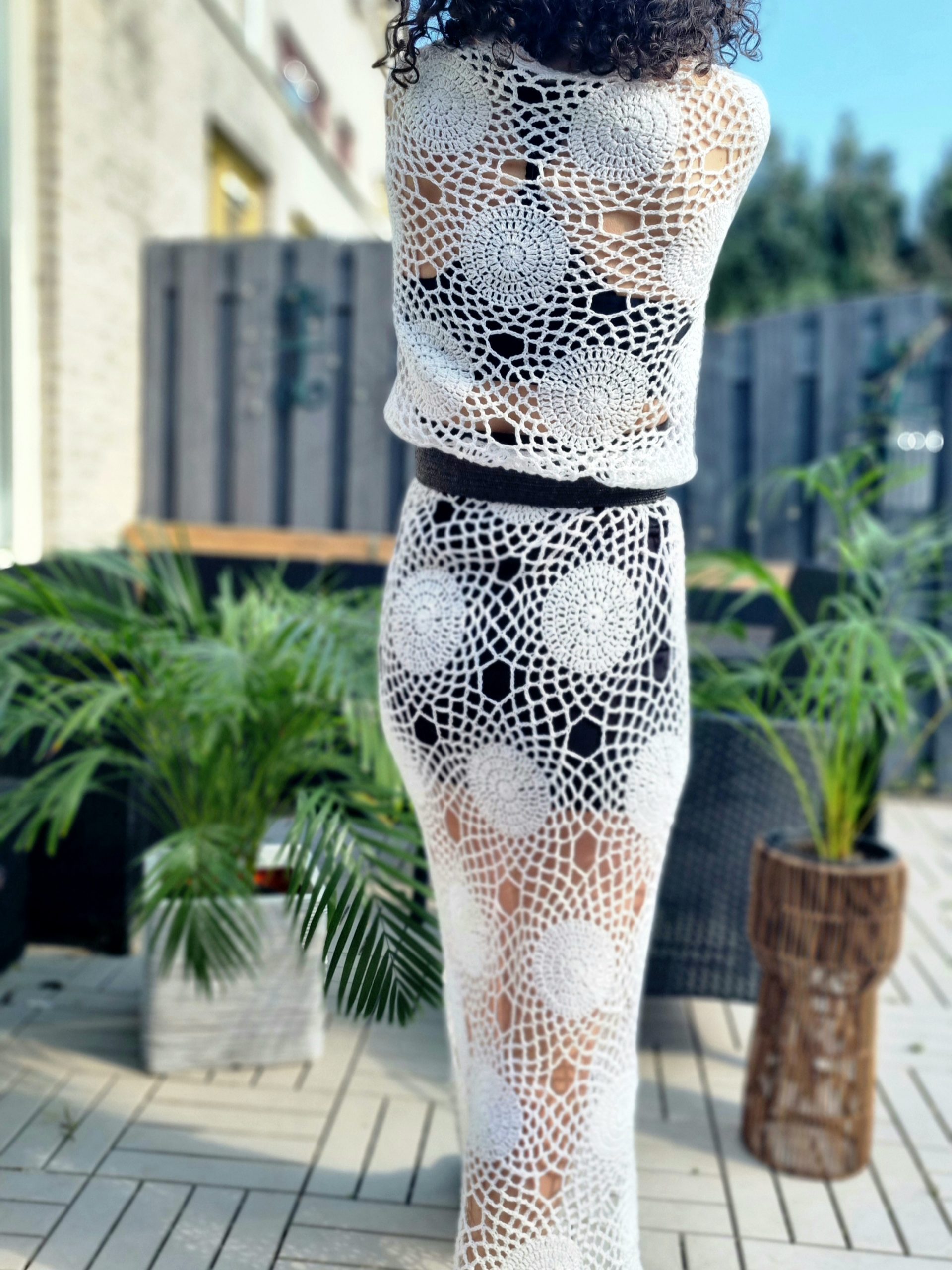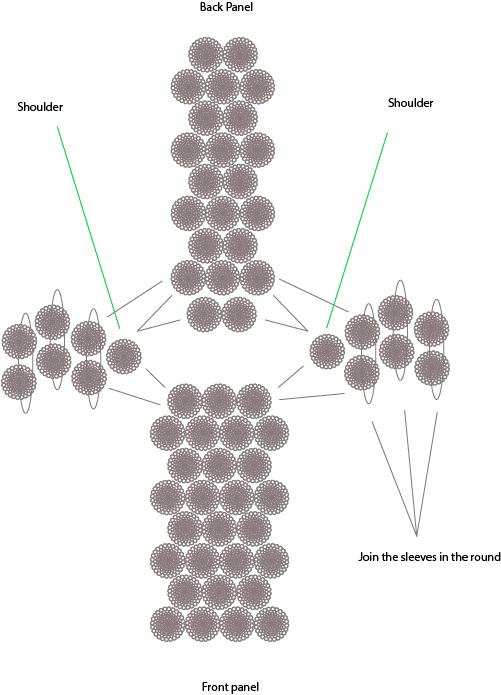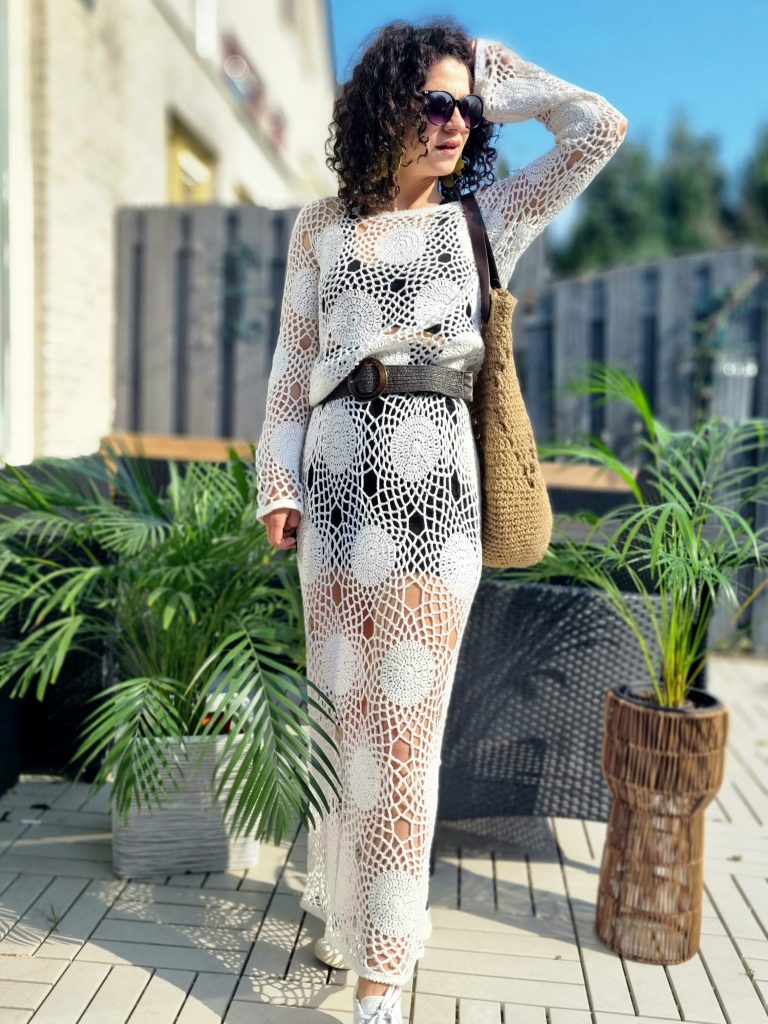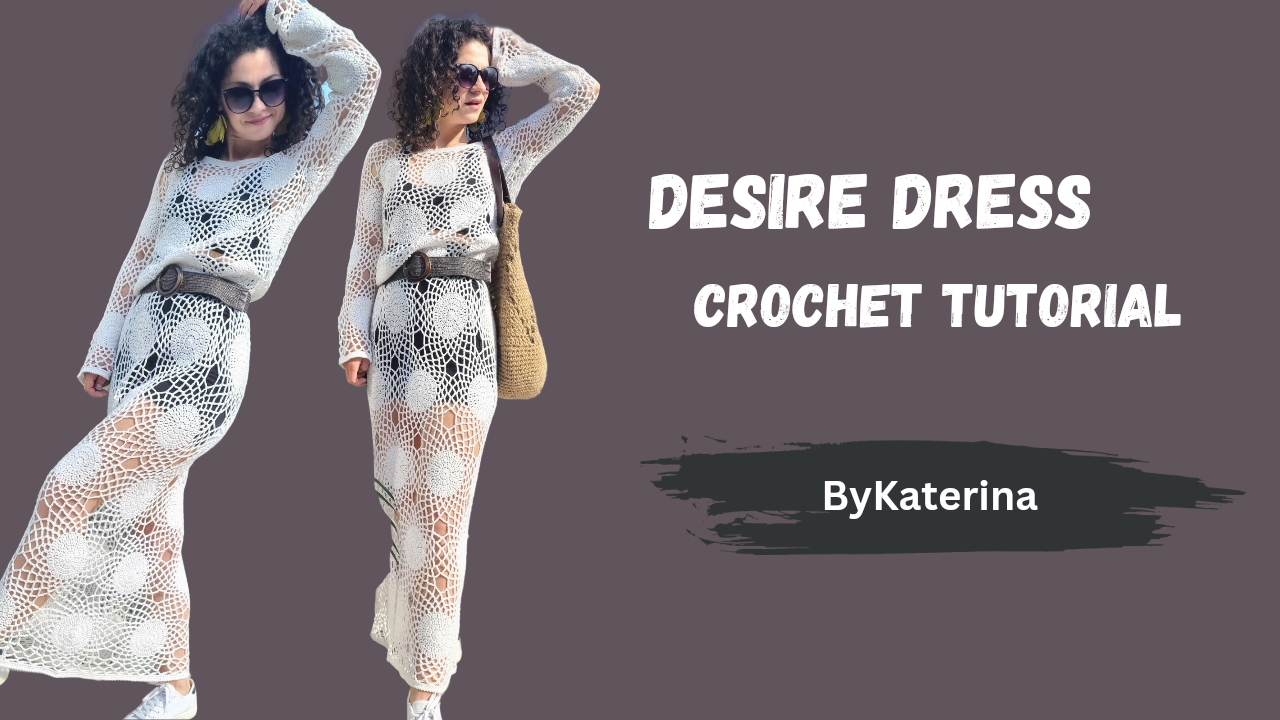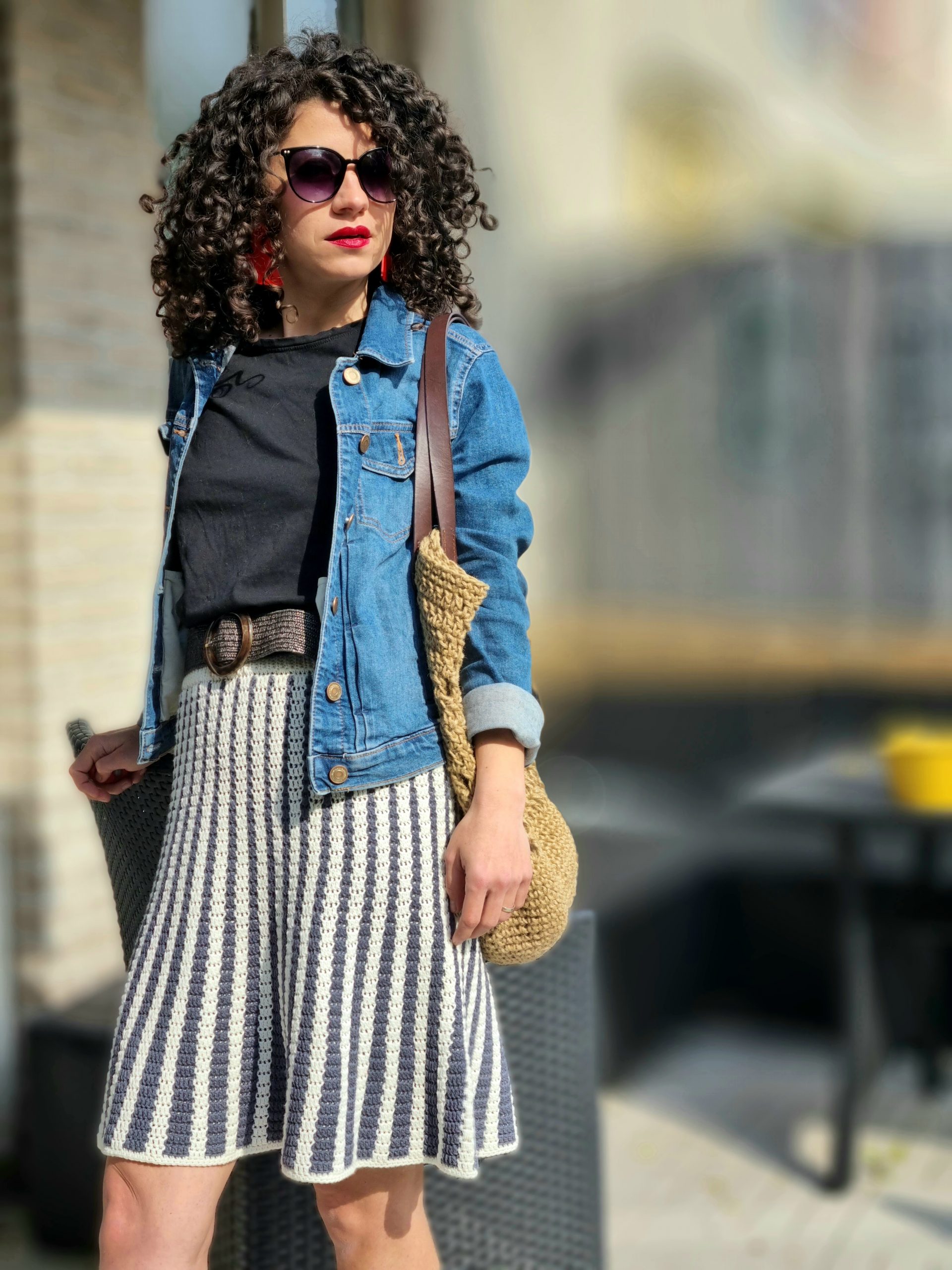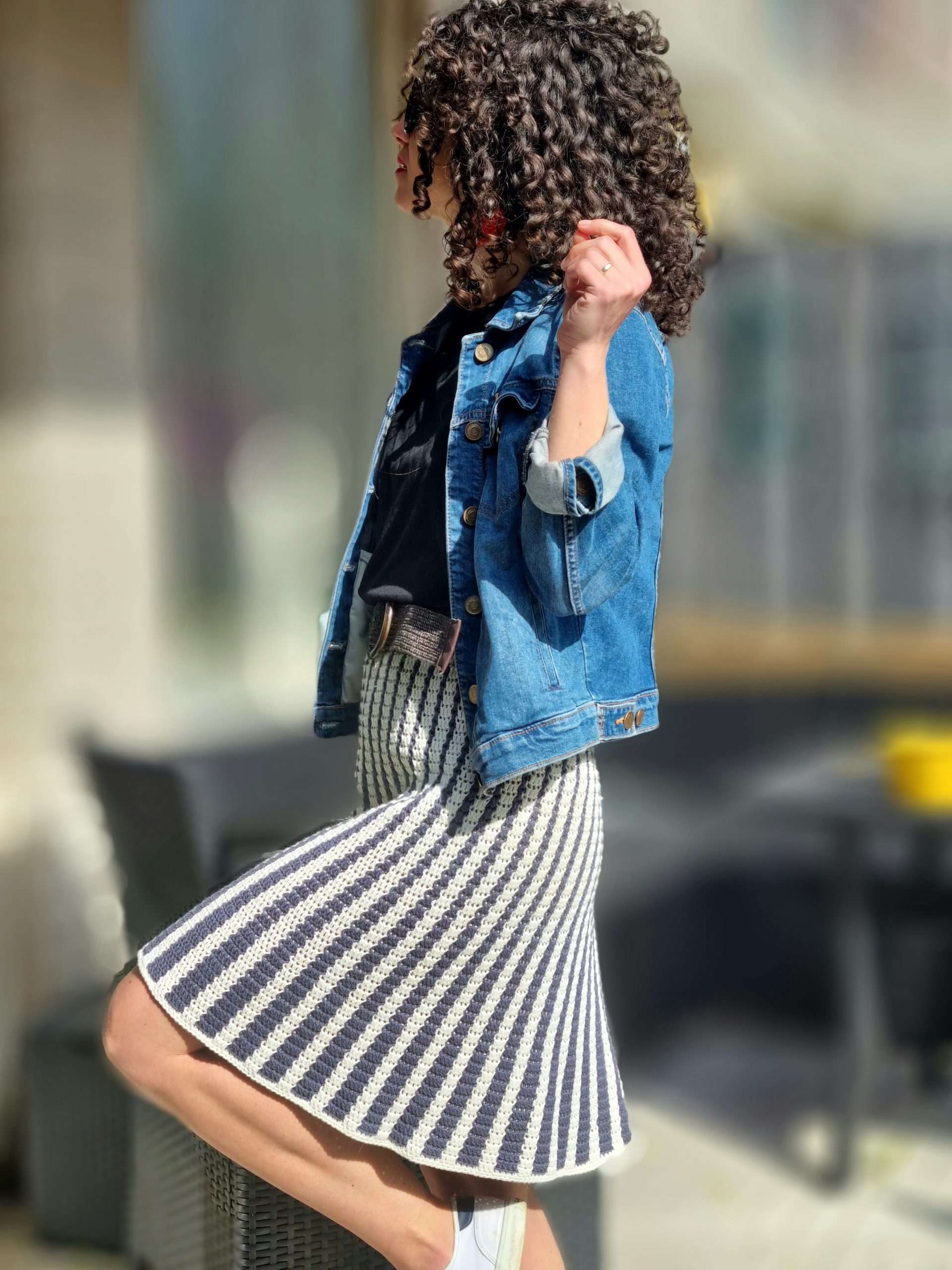I was lucky back in October to work with the amazing Adiahna by Ancestral Fiber and Co, and make the Demerzael Sweater. She invited me to design something for her collection of yarn inspired by a Movie Series.
Now, I will share how you can make this amazing sweater. After Sella Jumper, this is my second design using saddle sleeves, and it won’t be the last. I love this construction and how the sweater fits. I know you are excited to see and make this Demerzael Sweater because all the positive feedback blew me away. I am so grateful to be part of this amazing community.
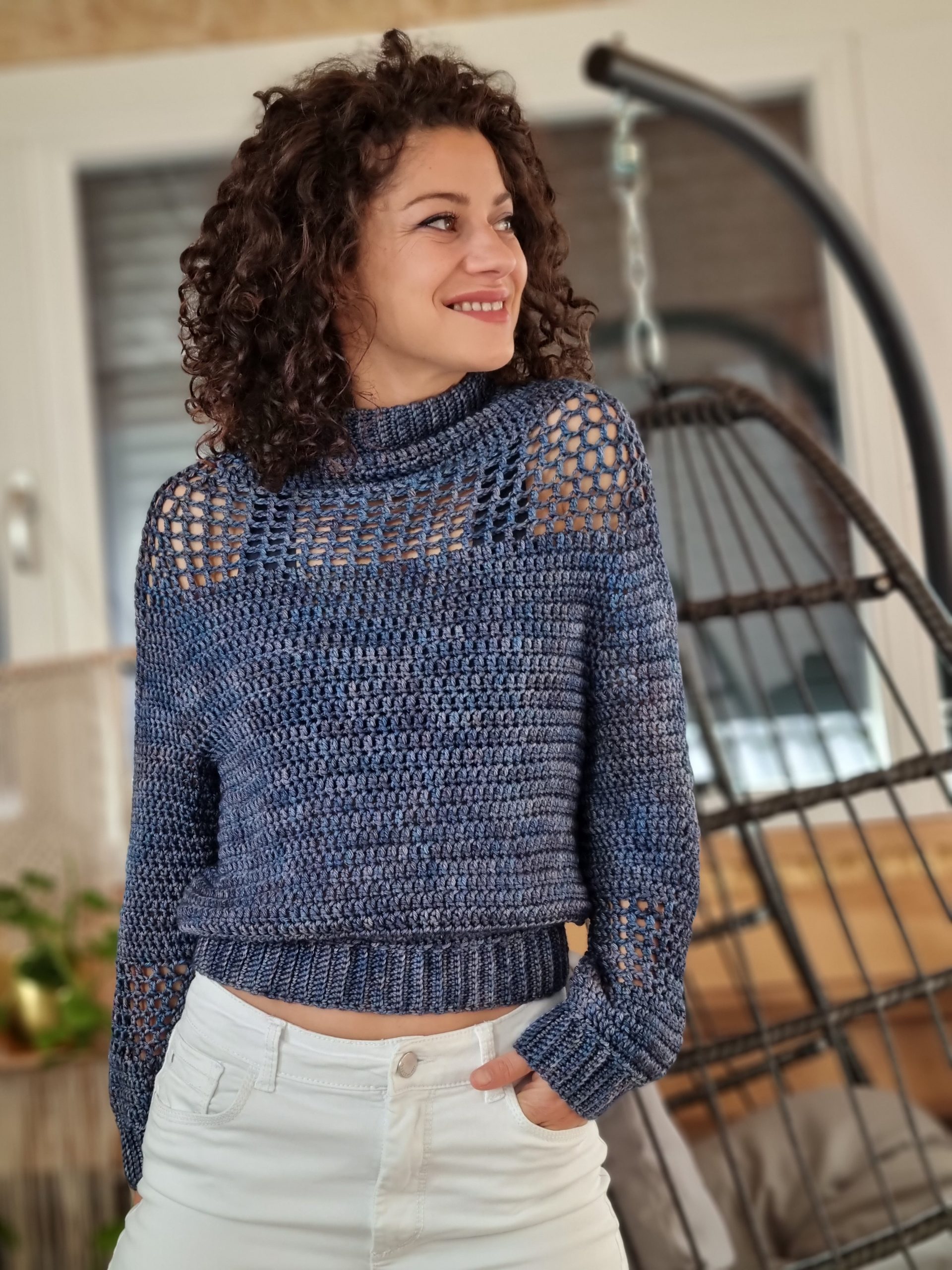
You can purchase the easily printable PDF pattern here at the links below. The PDF contains stitch charts also.
And because I have nothing else to say, I will jump into the pattern.
MATERIALS
• Yarn: Size 3, DK weight yarn
• Crochet Hook:
o 4.5 mm crochet hook for the Ribbing
o 5.5 mm crochet hook for the rest of the sweater
• yarn needle for weaving in ends
• at least 4 stitch markers
• Scissors
NOTES ABOUT DESIGN
The Demerzael Sweater is a top-down sweater with a unique yoke construction.
The yoke is worked in 2 sections: the first one, increasing only the front and back panel, and the second one, increasing the sleeves. For bigger sizes, Section 2 has 2 Parts: one, increasing only the sleeves, and second, increasing the sleeves and the front and back panels.
After finishing the yoke, the piece is split into sleeves and body. The three parts are worked individually until the desired length.
MEASUREMENTS AND SIZES
The Demerzael Sweater Pattern is available in 9 sizes, from XS up to 5X Large. The model is 168 cm tall, with an 86 cm Bust circumference, and wears a size Extra Small.
The numbers are written below as follows: XS (S, M, L) (XL, 2XL, 3XL, 4XL, 5XL); US sizes 0/2 (4/6, 8/10, 12/14) (14/16W, 18/20W, 22/24W, 26/28W, 30/32W)
All the measurements use as reference Standard Body Measurements by ASTM International.
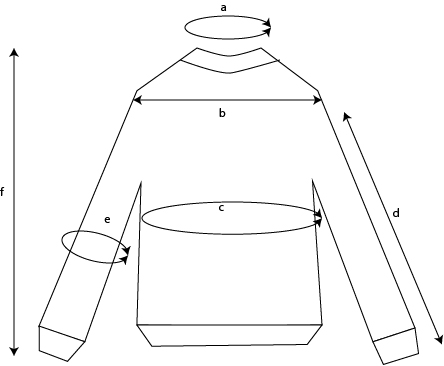
Final Measurements of the Demerzael Sweater
Neckline circ a: 43 cm (46, 49, 49) (49, 51, 54, 54, 54)
Cross Back b: 38cm (39, 40, 41), (41, 41, 43, 44, 46)
Bust Circ. c: 92 cm (95, 102, 108), (118, 128, 138, 148, 155)
Sleeve length d: 59 cm (61, 63, 65), (68, 68, 69, 75, 79)
Sleeve Circ. e: 33cm (34, 38, 39), (43, 44, 49, 53, 56)
Length f:53cm (55, 56, 59) (60, 60, 61, 65, 68)
How much yarn do you need?
For the Demerzael Sweater, I used the following:
Sample 1 (Blue): Ancestral Silk DK in color Demerzael; Yarn composition: 75% Super Washed Merino & 25% Silk; Each Hank has 100 grams and is approximately 225 meters (246 yards)
Sample 2 (green): DK 100% recycled cotton yarn
For each size, you will approximately need:
780 (840, 920, 1020) (1140, 1220, 1350, 1550, 1710) meters
ABBREVIATIONS
Ch – chain
Sc – single crochet
Scblo – single crochet back loop
dc – double crochet
ss – slip stitch
St(s) – stitch(es)
RS – right side
WS – wrong side
R – round
** – repeated section.
TENSION
Using a 4.5.mm crochet hook in the Ribbing Stitch Pattern
14sts (scblo) = 10cm
14 rows = 10cm
Using a 5.5 mm crochet hook in double crochet
12sts = 10cm
7.5 rounds = 10cm

You can purchase the easily printable PDF pattern here at the links below. The PDF contains stitch charts also.
STITCH PATTERNS AND TECHNIQUES
The Demerzael Sweater stitch patterns are double crochet, double crochet mesh stitch, and single crochet in the back loop only for Ribbing.
Single crochet in the back loop
Insert the hook into the back loop of the next st, yarn over, pull out a loop, yarn over, and pass through both loops on your hook.
Double Crochet
Yarn over, insert the hook into the next stitch, yarn over, pull out a loop, yarn over, pull it through the first 2 loops on your hook, yarn over, and pass it through both loops on your hook.
Double Crochet Mesh Stitch
R1:*1dc, 1ch, skip 1st. *rep. until the end of the round.
PATTERN NOTES
- Work the neckline ribbing falt; turn after each row
- When working across the ribbing’s side rows, each side row represents 1st
- Work the rest of the sweater in the round; close each round with an sl st into the first dc; to avoid your work twisting, turn after each round;
- Begin each round with 2ch; 2ch does not count as the first dc; optional, you can start each round with 1sc on top of other sc; (see how to make this starting stitch in the video tutorial here)
- use stitch markers to mark the front and back panels’ sts and the sleeves’ sts; you can use different color stitch markers to know which one belongs to which section

You can purchase the easily printable PDF pattern here at the links below. The PDF contains stitch charts also.
INSTRUCTIONS
NECKLINE RIBBING
Using the 4.5mm crochet hook ch15
R1: start in the second st from the hook
1sc in each st until the end of the row. 1ch and turn.
R2: 1sc, 1scblo in next 13 sts, 1sc in last st, 1ch and turn
Rep. R2 until you will have in total: 60 (64, 68, 68) (68, 72, 76, 76, 76)
Join the ends of the ribbing using slip stitches.
Fold the ribbing and ensure the edges of the rows are perfectly aligned.
From where your yarn is, work 1ch and then 1sc into each side row, through both side edges, until you complete the round,
At the end of this round, you should have 60 (64, 68, 68) (68, 72, 76, 76, 76) sc.
YOKE SECTION 1 – INCREASING FRONT AND BACK PANELS
Use a 5.5 mm crochet hook.
At the end of the document, you will find stitch charts with the YOKE Sections.
Before starting this section, use at least 4 stitch markers to mark the front and back panels. You can also use another 4 to mark the sleeves’ sts, but we will increase only the front and back panels in this section.
With each round, move the sts marker into the first and last st of the section (front and back panel); these sts will always be next to the sleeve sts.
Place 1 st marker into the first st, the second st marker into st number 25 (27, 29, 29) (29, 29, 31, 31, 31), and the third st. marker into st number 31 (33, 35, 35) (35, 37, 39, 39, 39), and the fourth st marker into stitch number 55 (59, 63, 63) (63, 65, 69, 69, 69).
You will have 25 (27, 29, 29) (29, 29, 31, 31, 31) sts for back and front panels and 5 (5, 5, 5) (5, 7, 7, 7, 7) sts for the sleeves.
In all following instructions, the first st in a round will be written as dc; you will work the starting st as you find it easier (3ch, 2ch, and 1dc, or 1sc and another sc on top of it); all the RS rounds will start with an increase (3dc in the same st), which at the beginning of the round will be your first starting st plus another 2dc.
R1 (RS) : *3dc, 1dc in next 23 (25, 27, 27) (27, 27, 29, 29, 29) sts, 3dc in next st, 1ch skip 1st, (1dc in next, 1ch, skip 1st) x 2 (2, 2, 2) (2, 3, 3, 3, 3) times*; Rep. from * to * one more time; slst into the first st, turn;
Total sts:
Front and back panels: 29 (31, 33, 33) (33, 33, 35, 35, 35)
Sleeves: 5 (5, 5, 5) (5, 7, 7, 7, 7) sts
R2 (WS): 1dc, 1ch skip 1st, (1dc in next, 1ch, skip 1st) x2 (2, 2, 2) (2, 3, 3, 3, 3) times, 3dc in next st, 1dc in next 27 (29, 31, 31) (31, 31, 33, 33, 33)sts, 3dc in next, 1ch skip 1st, (1dc in next, 1ch, skip 1st) x2 (2, 2, 2) (2, 3, 3, 3, 3) times, 3dc in next st, 1dc in next 27 (29, 31, 31) (31, 31, 33, 33, 33)sts, 2dc into the last st (same st as first dc), slst, turn
Total sts:
Front and back panels: 33 (35, 37, 37) (37, 37, 39, 39, 39)
Sleeves: 5 (5, 5, 5) (5, 7, 7, 7, 7) sts
R3 (RS): *3dc, 1dc in next 31 (33, 35, 35) (35, 35, 37, 37, 37) sts, 3dc in next, 1ch skip 1ch-sp, (1dc in next, 1ch, skip 1ch-sp) x2 (2, 2, 2) (2, 3, 3, 3, 3) times*; Rep. from * to * one more time; slst into the first st, turn;
Total sts:
Front and back panels: 37 (39, 41, 41) (41, 41, 43, 43, 43)
Sleeves: 5 (5, 5, 5) (5, 7, 7, 7, 7) sts
R4 (WS): 1dc, 1ch skip 1ch-sp, (1dc in next, 1ch, skip 1ch-sp) x2 (2, 2, 2) (2, 3, 3, 3, 3) times, 3dc in next st, 1dc in next 35 (37, 39, 39) (39, 39, 41, 41, 41)sts, 3dc in next, 1ch skip 1ch-sp, (1dc in next, 1ch, skip 1ch-sp) x2 (2, 2, 2) (2, 3, 3, 3, 3) times, 3dc in next st, 1dc in next 35 (37, 39, 39) (39, 39, 41, 41, 41)sts, 2dc into the last st (same st as first dc), slst, turn
Total sts:
Front and back panels: 41 (43, 45, 45) (45, 45, 47, 47, 47)
Sleeves: 5 (5, 5, 5) (5, 7, 7, 7, 7) sts
R5 (RS): *3dc, 1dc in next 39 (41, 43, 43) (43, 43, 45, 45, 45) sts, 3dc in next, 1ch skip 1ch-sp, (1dc in next, 1ch, skip 1ch-sp) x2 (2, 2, 2) (2, 3, 3, 3, 3) times*; Rep. from * to * one more time; slst into the first st, turn;
Total sts:
Front and back panels: 45 (47, 49, 49) (49, 49, 51, 51, 51)
Sleeves: 5 (5, 5, 5) (5, 7, 7, 7, 7) sts
For sizes XS, S, and M, YOKE SECTION 1 is done; move to YOKE SECTION 2
Sizes L, XL, 2XL, 3XL, 4XL, and 5XL only
R6 (WS): 1dc, 1ch skip 1ch-sp, (1dc in next, 1ch, skip 1ch-sp) x – (-, -, 2) (2, 3, 3, 3, 3) times, 3dc in next st, 1dc in next – (-, -, 47) (47, 47, 49, 49, 49) sts, 3dc in next, 1ch skip 1ch-sp, (1dc in next, 1ch, skip 1ch-sp) x – (-, -, 2) (2, 3, 3, 3, 3) times, 3dc in next st, 1dc in next – (-, -, 47) (47, 47, 49, 49, 49) sts
2dc into the last st (same st as the first dc), slst, turn.
Total sts:
Front and back panels: – (-, -, 53) (53, 53, 55, 55, 55)
Sleeves: – (-, -, 5) (5, 7, 7, 7, 7) sts
For sizes L, XL, 2XL, and 3XL, YOKE SECTION 1 is done; move to YOKE SECTION 2
Sizes 4XL and 5XL only
R7 (RS): *3dc, 1dc in next – (-, -, -) (-, -, -, 53, 53) sts, 3dc in next, 1ch skip 1ch-sp, (1dc in next, 1ch, skip 1ch-sp) x – (-, -, -) (-, -, -, 3, 3) times times*; Rep. from * to * one more time; slst into the first st, turn;
Total sts:
Front and back panels: – (-, -, -) (-, -, -, 59, 59)
Sleeves: – (-, -, -) (-, -, -, 7, 7) sts
For sizes 4XL, and 5XL, YOKE SECTION 1 is done; move to YOKE SECTION 2
After completing the YOKE SECTION 1, you should have:
Total sts:
Front and back panels: 45 (47, 49, 53, 53, 53, 55, 59, 59) sts
Sleeves: 5 (5, 5, 5) (5, 7, 7, 7, 7) sts
YOKE SECTION 2 – INCREASING SLEEVES
If you didn’t use stitch markers for the sleeves’ sts until now, you should place them before starting YOKE SECTION 2. The first and last st of the sleeve will be the 1ch-sp after and before the back and front panels.
With each round, you will increase into the sts next to the back and front panels. The number of sts for front and back panels remains the same.
You must keep the 5 or 7 sts in the middle of the sleeve into the mesh stitch pattern.
The YOKE SECTION 2 will have first rounds with a mesh stitch pattern on the front panel. You can work with dc stitches instead of a mesh stitch pattern to solidify this section.
In this section, the increase will be 2dc in the same st, instead of 3dc. You don’t have to increase the front and back panels, only the sleeves.
YOKE SECTION 2 – INCREASING SLEEVES
Size XS, S, and M
The numbers below are written as follows: XS (S, M)
R6 (WS): 1dc, 1dc into the next 1ch-sp, 1ch, 1dc in next dc, 1ch, skip 1ch-sp, 1dc in next dc, 1ch, 1dc in next 1ch-sp, 1dc in next st, (1ch, skip 1st, 1dc in next st) for the next 44 (46, 48) sts – front panel’s sts, 1dc into the next 1ch-sp, 1ch, 1dc in next dc, 1ch, skip 1ch-sp, 1dc in next dc, 1ch, 1dc in next 1ch-sp, 1dc in next 44 (46, 48) sts, slst into the first dc, turn
Total sts:
Front and back panels: 45 (47, 49)
Sleeves: 7(7, 7) sts
R7 (RS): 1dc in next 45 (47, 49) sts, 2dc in next st, 1ch, skip 1ch-sp, (1dc in next st, 1ch, skip 1ch-sp) x 2 (2, 2) times, 2dc in next st, 1dc in next st, (1ch, skip 1ch-sp, 1dc in next st) for the next 44 (46, 48) sts – front panel’s sts, 2dc in next st, 1ch, skip 1ch-sp, (1dc in next st, 1ch, skip 1ch-sp) x 2 (2, 2) times, 2dc in next st, slst into first dc, turn.
Total sts:
Front and back panels: 45 (47, 49)
Sleeves: 9(9, 9) sts
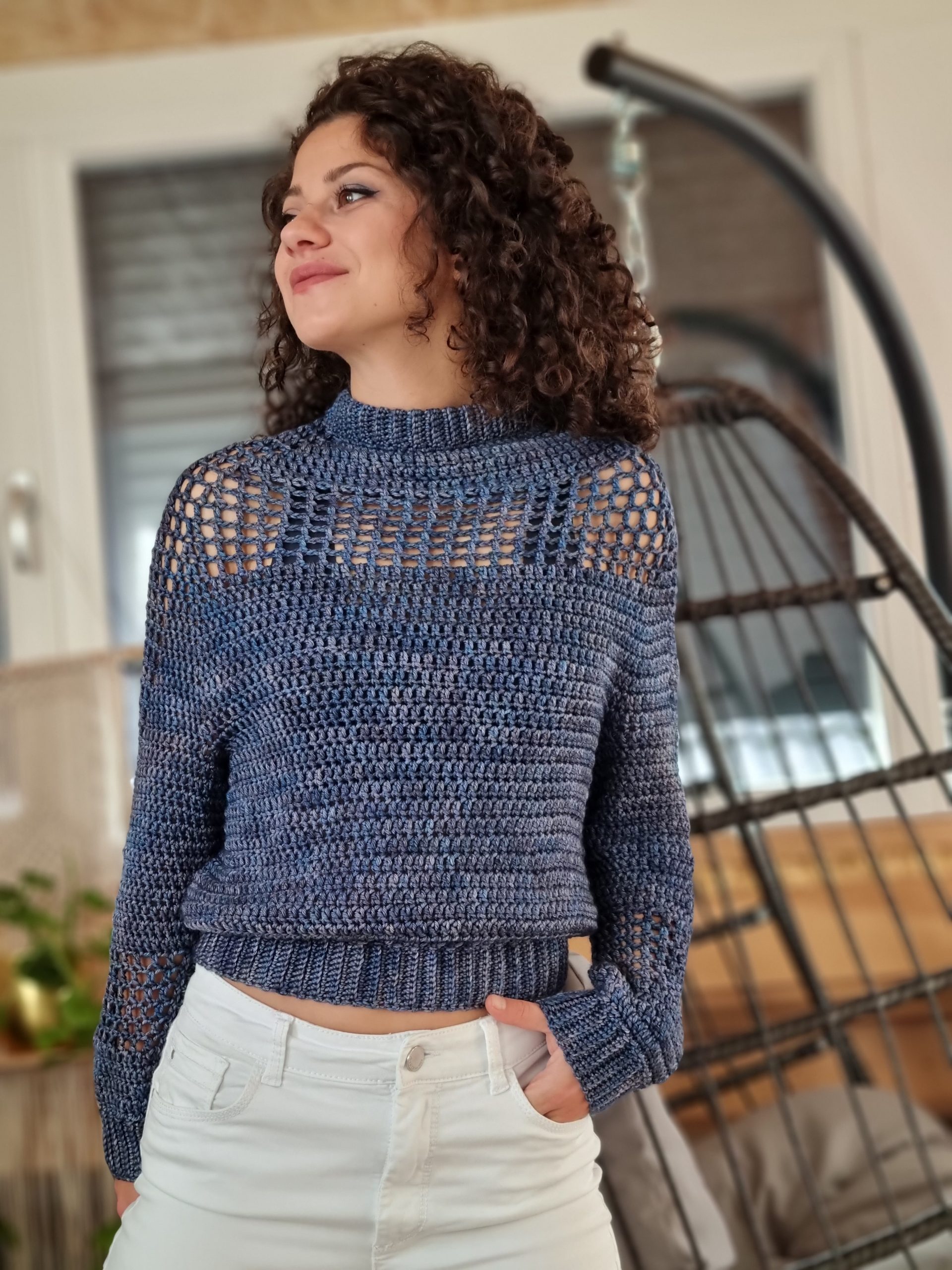
You can purchase the easily printable PDF pattern here at the links below. The PDF contains stitch charts also.
R8: (WS): 1dc, 2dc in the next st, 1dc in next st, 1ch, skip 1ch-sp, (1dc in next st, 1ch, skip 1ch-sp) x 2 (2, 2) times, 1dc in next st, 2dc in next st, 1dc in next st, ((1ch, skip 1ch-sp, 1dc in next st) for the next 44 (46, 48) sts – front panel’s sts, 2dc in next st, 1dc in next st, 1ch, skip 1ch-sp, (1dc in next st, 1ch, skip 1ch-sp) x 2 (2, 2) times, 1dc in next st, 2dc in next st, 1dc in next 44 (46, 48) sts, slst into the first dc, turn.
Total sts:
Front and back panels: 45 (47, 49)
Sleeves: 11(11, 11) sts
R9 (RS): 1dc in next 45 (47, 49) sts, 2dc in the next st, 1dc in next 2sts, 1ch, skip 1ch-sp, (1dc in next st, 1ch, skip 1ch-sp) x 2 (2, 2) times, 1dc in next 2sts, 2dc in next st, 1dc in next st, (1ch, skip 1ch-sp, 1dc in next st) for the next 44 (46, 48) sts – front panel’s sts, 2dc in the next st, 1dc in next 2sts, 1ch, skip 1ch-sp, (1dc in next st, 1ch, skip 1ch-sp) x 2 (2, 2) times, 1dc in next 2sts, 2dc in next st, slst into the first dc, turn.
Total sts:
Front and back panels: 45 (47, 49)
Sleeves: 13(13, 13) sts
R10 (WS): 1dc, 2dc in next st, 1dc in next 3sts, 1ch, skip 1ch-sp, (1dc in next st, 1ch, skip 1ch-sp) x 2 (2, 2) times, 1dc in next 3sts, 2dc in next st, 1dc in next st, (1ch, skip 1ch-sp, 1dc in next st) for the next 44 (46, 48) sts – front panel’s sts, 2dc in next st, 1dc in next 3sts, 1ch, skip 1ch-sp, (1dc in next st, 1ch, skip 1ch-sp) x 2 (2, 2) times, 1dc in next 3sts, 2dc in next st, 1dc in next 44 (46,48) sts, slst into the first dc, turn.
Total sts:
Front and back panels: 45 (47, 49)
Sleeves: 15(15, 15) sts
R11 (RS): 1dc in next 45 (47, 49) sts, 2dc in the next st, 1dc in next 4sts, 1ch, skip 1ch-sp, (1dc in next st, 1ch, skip 1ch-sp) x 2 (2, 2) times, 1dc in next 4sts, 2dc in next st, 1dc in next st, (1ch, skip 1ch-sp, 1dc in next st) for the next 44 (46, 48) sts – front panel’s sts, 2dc in the next st, 1dc in next 4sts, 1ch, skip 1ch-sp, (1dc in next st, 1ch, skip 1ch-sp) x 2 (2, 2) times, 1dc in next 4sts, 2dc in next st, slst into the first dc, turn.
Total sts:
Front and back panels: 45 (47, 49)
Sleeves: 17(17, 17) sts
R12 (WS): 1dc, 2dc in next st, 1dc in next 5sts, 1ch, skip 1ch-sp, (1dc in next st, 1ch, skip 1ch-sp) x 2 (2, 2) times, 1dc in next 5sts, 2dc in next st, 1dc in next st, (1ch, skip 1ch-sp, 1dc in next st) for the next 44 (46, 48) sts – front panel’s sts, 2dc in next st, 1dc in next 5sts, 1ch, skip 1ch-sp, (1dc in next st, 1ch, skip 1ch-sp) x 2 (2, 2) times, 1dc in next 5sts, 2dc in next st, 1dc in next 44 (46,48) sts, slst into the first dc, turn.
Total sts:
Front and back panels: 45 (47, 49)
Sleeves: 19(19, 19) sts
Starting with R13, the pattern for the front panel will be in dc sts, the same as for the back panel.
We will continue to increase the sleeves.
R13 (RS): 1dc in next 45 (47, 49) sts, 2dc in the next st, 1dc in next 6sts, 1ch, skip 1ch-sp, (1dc in next st, 1ch, skip 1ch-sp) x 2 (2, 2) times, 1dc in next 6sts, 2dc in next st, 1dc in next 45 (47, 49) sts, 2dc in the next st, 1dc in next 6sts, 1ch, skip 1ch-sp, (1dc in next st, 1ch, skip 1ch-sp) x 2 (2, 2) times, 1dc in next 6sts, 2dc in next st, slst into the first dc, turn.
Total sts:
Front and back panels: 45 (47, 49)
Sleeves: 21(21, 21) sts
R14 (WS): 1dc, 2dc in next st, 1dc in next 7sts, 1ch, skip 1ch-sp, (1dc in next st, 1ch, skip 1ch-sp) x 2 (2, 2) times, 1dc in next 7sts, 2dc in next st, 1dc in next 45 (47, 49)sts, 2dc in next st, 1dc in next 7sts, 1ch, skip 1ch-sp, (1dc in next st, 1ch, skip 1ch-sp) x 2 (2, 2) times, 1dc in next 7sts, 2dc in next st, 1dc in next 44 (46,48) sts, slst into the first dc, turn.
Total sts:
Front and back panels: 45 (47, 49)
Sleeves: 23(23, 23) sts
R15 (RS): 1dc in next 45 (47, 49) sts, 2dc in the next st, 1dc in next 8sts, 1ch, skip 1ch-sp, (1dc in next st, 1ch, skip 1ch-sp) x 2 (2, 2) times, 1dc in next 8sts, 2dc in next st, 1dc in next 45 (47, 49) sts, 2dc in the next st, 1dc in next 8sts, 1ch, skip 1ch-sp, (1dc in next st, 1ch, skip 1ch-sp) x 2 (2, 2) times, 1dc in next 8sts, 2dc in next st, slst into the first dc, turn.
Total sts:
Front and back panels: 45 (47, 49)
Sleeves: 25(25, 25) sts
R16 (WS): 1dc, 2dc in next st, 1dc in next 9sts, 1ch, skip 1ch-sp, (1dc in next st, 1ch, skip 1ch-sp) x 2 (2, 2) times, 1dc in next 9sts, 2dc in next st, 1dc in next 45 (47, 49)sts, 2dc in next st, 1dc in next 9sts, 1ch, skip 1ch-sp, (1dc in next st, 1ch, skip 1ch-sp) x 2 (2, 2) times, 1dc in next 9sts, 2dc in next st, 1dc in next 44 (46,48) sts, slst into the first dc, turn.
Total sts:
Front and back panels: 45 (47, 49)
Sleeves: 27(27, 27) sts
For size XS the YOKE SECTION 2 is done; move to the BODY section
Sizes S and M only
R17 (RS): 1dc in next 45 (47, 49) sts, 2dc in the next st, 1dc in next 10sts, 1ch, skip 1ch-sp, (1dc in next st, 1ch, skip 1ch-sp) x 2 (2, 2) times, 1dc in next 10sts, 2dc in next st, 1dc in next 45 (47, 49) sts, 2dc in the next st, 1dc in next 10sts, 1ch, skip 1ch-sp, (1dc in next st, 1ch, skip 1ch-sp) x 2 (2, 2) times, 1dc in next 10sts, 2dc in next st, slst into the first dc, turn.
Total sts:
Front and back panels: – (47, 49)
Sleeves: – (29, 29) sts
For size S the YOKE SECTION 2 is done; move to the BODY section
Sizes M only
R18 (WS): 1dc, 2dc in next st, 1dc in next 11sts, 1ch, skip 1ch-sp, (1dc in next st, 1ch, skip 1ch-sp) x 2 (2, 2) times, 1dc in next 11sts, 2dc in next st, 1dc in next 45 (47, 49)sts, 2dc in next st, 1dc in next 11sts, 1ch, skip 1ch-sp, (1dc in next st, 1ch, skip 1ch-sp) x 2 (2, 2) times, 1dc in next 11sts, 2dc in next st, 1dc in next 44 (46,48) sts, slst into the first dc, turn.
Total sts:
Front and back panels: – (-, 49)
Sleeves: – (-, 31) sts
For size M the YOKE SECTION 2 is done; move to the BODY section
YOKE SECTION 2 – INCREASING SLEEVES
Size L, XL, 2XL and 3XL
The numbers below are written as follows: L (XL, 2XL, 3XL)
R7 (RS): 1dc in next 53 (53, 53, 55) sts, 1dc in next ch-sp, 1ch, 1dc in next dc, (1ch, skip 1ch-sp, 1dc in next dc) x 1( 1, 2, 2) times, 1ch, 1dc in next 1ch-sp, 1dc in next st, (1ch, skip 1st, 1dc in next st) for the next 52 (52, 52, 54) sts – front panel’s sts, 1dc into the next 1ch-sp, 1ch, 1dc in next dc, (1ch, skip 1ch-sp, 1dc in next dc) x 1( 1, 2, 2) times, 1ch, 1dc in next 1ch-sp, slst into first dc, turn.
Total sts:
Front and back panels: 53 (53, 53, 55)
Sleeves: 7(7, 9, 9) sts
R8( WS): 1dc, 2dc in the next st, 1ch, skip 1ch-sp, (1dc in next st, 1ch, skip 1ch-sp) x 2 (2, 3, 3) times, 2dc in next st, 1dc in next st, (1ch, skip 1ch-sp, 1dc in next st) for the next 52 (52, 52, 54) sts – front panel’s sts, 2dc in next st, 1ch, skip 1ch-sp, (1dc in next st, 1ch, skip 1ch-sp) x 2 (2, 3, 3) times, 2dc in next st, 1dc in next 52 (52, 52, 54) sts, slst into the first dc, turn.
Total sts:
Front and back panels: 53 (53, 53, 55)
Sleeves: 9(9, 11, 11) sts
R9 (RS): 1dc in next 53 (53, 53, 55) sts, 2dc in the next st, 1dc in next st, 1ch, skip 1ch-sp, (1dc in next st, 1ch, skip 1ch-sp) x 2 (2, 3, 3) times, 1dc in next st, 2dc in next st, 1dc in next st, (1ch, skip 1ch-sp, 1dc in next st) for the next 52 (52, 52, 54) sts – front panel’s sts, 2dc in the next st, 1dc in next st, 1ch, skip 1ch-sp, (1dc in next st, 1ch, skip 1ch-sp) x 2 (2, 3, 3) times, 1dc in next st, 2dc in next st, slst into the first dc, turn.
Total sts:
Front and back panels: 53 (53, 53, 55)
Sleeves: 11 (11, 13, 13) sts
R10( WS): 1dc, 2dc in the next st, 1dc in next 2sts, 1ch, skip 1ch-sp, (1dc in next st, 1ch, skip 1ch-sp) x 2 (2, 3, 3) times, 1dc in next 2sts, 2dc in next st, 1dc in next st, (1ch, skip 1ch-sp, 1dc in next st) for the next 52 (52, 52, 54) sts – front panel’s sts, 2dc in next st, 1dc in next 2sts, 1ch, skip 1ch-sp, (1dc in next st, 1ch, skip 1ch-sp) x 2 (2, 3, 3) times, 1dc in next 2sts, 2dc in next st, 1dc in next 52 (52, 52, 54) sts, slst into the first dc, turn.
Total sts:
Front and back panels: 53 (53, 53, 55)
Sleeves: 13 (13, 15, 15) sts
R11 (RS): 1dc in next 53 (53, 53, 55) sts, 2dc in the next st, 1dc in next 3sts, 1ch, skip 1ch-sp, (1dc in next st, 1ch, skip 1ch-sp) x 2 (2, 3, 3) times, 1dc in next 3sts, 2dc in next st, 1dc in next st, (1ch, skip 1ch-sp, 1dc in next st) for the next 52 (52, 52, 54) sts – front panel’s sts, 2dc in the next st, 1dc in next 3sts, 1ch, skip 1ch-sp, (1dc in next st, 1ch, skip 1ch-sp) x 2 (2, 3, 3) times, 1dc in next 3sts, 2dc in next st, slst into the first dc, turn.
Total sts:
Front and back panels: 53 (53, 53, 55)
Sleeves: 15 (15, 17, 17) sts
R12 ( WS): 1dc, 2dc in the next st, 1dc in next 4sts, 1ch, skip 1ch-sp, (1dc in next st, 1ch, skip 1ch-sp) x 2 (2, 3, 3) times, 1dc in next 4sts, 2dc in next st, 1dc in next st, (1ch, skip 1ch-sp, 1dc in next st) for the next 52 (52, 52, 54) sts – front panel’s sts, 2dc in next st, 1dc in next 4sts, 1ch, skip 1ch-sp, (1dc in next st, 1ch, skip 1ch-sp) x 2 (2, 3, 3) times, 1dc in next 4sts, 2dc in next st, 1dc in next 52 (52, 52, 54) sts, slst into the first dc, turn.
Total sts:
Front and back panels: 53 (53, 53, 55)
Sleeves: 17 (17, 19, 19) sts
R13 (RS): 1dc in next 53 (53, 53, 55) sts, 2dc in the next st, 1dc in next 5sts, 1ch, skip 1ch-sp, (1dc in next st, 1ch, skip 1ch-sp) x 2 (2, 3, 3) times, 1dc in next 5sts, 2dc in next st, 1dc in next st, (1ch, skip 1ch-sp, 1dc in next st) for the next 52 (52, 52, 54) sts – front panel’s sts, 2dc in the next st, 1dc in next 5sts, 1ch, skip 1ch-sp, (1dc in next st, 1ch, skip 1ch-sp) x 2 (2, 3, 3) times, 1dc in next 5sts, 2dc in next st, slst into the first dc, turn.
Total sts:
Front and back panels: 53 (53, 53, 55)
Sleeves: 19 (19, 21, 21) sts
R14 ( WS): 1dc, 2dc in the next st, 1dc in next 6sts, 1ch, skip 1ch-sp, (1dc in next st, 1ch, skip 1ch-sp) x 2 (2, 3, 3) times, 1dc in next 6sts, 2dc in next st, 1dc in next st, (1ch, skip 1ch-sp, 1dc in next st) for the next 52 (52, 52, 54) sts – front panel’s sts, 2dc in next st, 1dc in next 6sts, 1ch, skip 1ch-sp, (1dc in next st, 1ch, skip 1ch-sp) x 2 (2, 3, 3) times, 1dc in next 6sts, 2dc in next st, 1dc in next 52 (52, 52, 54) sts, slst into the first dc, turn.
Total sts:
Front and back panels: 53 (53, 53, 55)
Sleeves: 21 (21, 23, 23) sts
For sizes L and XL, starting with R15, the pattern will change for the front panel into dc only, the same as for the back panel. For the sizes 2XL and 3XL, we will work 1 more row with a mesh st pattern.
Sizes L and XL only
R15 (RS): 1dc in next 53 (53, -, -) sts, 2dc in the next st, 1dc in next 7sts, 1ch, skip 1ch-sp, (1dc in next st, 1ch, skip 1ch-sp) x 2 (2, -, -) times, 1dc in next 7sts, 2dc in next st, 1dc in next 53 (53, -, -) sts, 2dc in the next st, 1dc in next 7sts, 1ch, skip 1ch-sp, (1dc in next st, 1ch, skip 1ch-sp) x 2 (2, -, -) times, 1dc in next 7sts, 2dc in next st, slst into the first dc, turn.
Total sts:
Front and back panels: 53 (53, -, -)
Sleeves: 23 (23, -, -) sts
R16 ( WS): 1dc, 2dc in the next st, 1dc in next 8sts, 1ch, skip 1ch-sp, (1dc in next st, 1ch, skip 1ch-sp) x 2 (2, -, -) times, 1dc in next 8sts, 2dc in next st, 1dc in next (53 (53, -, -) sts, 2dc in next st, 1dc in next 8sts, 1ch, skip 1ch-sp, (1dc in next st, 1ch, skip 1ch-sp) x 2 (2, -, -) times, 1dc in next 8sts, 2dc in next st, 1dc in next 52 (52, -, -) sts, slst into the first dc, turn.
Total sts:
Front and back panels: 53 (53, -, -)
Sleeves: 25 (25, -, -) sts
R17 (RS): 1dc in next 53 (53, -, -) sts, 2dc in the next st, 1dc in next 9sts, 1ch, skip 1ch-sp, (1dc in next st, 1ch, skip 1ch-sp) x 2 (2, -, -) times, 1dc in next 9sts, 2dc in next st, 1dc in next 53 (53, -, -) sts, 2dc in the next st, 1dc in next 9sts, 1ch, skip 1ch-sp, (1dc in next st, 1ch, skip 1ch-sp) x 2 (2, -, -) times, 1dc in next 9sts, 2dc in next st, slst into the first dc, turn.
Total sts:
Front and back panels: 53 (53, -, -)
Sleeves: 27 (27, -, -) sts
R18 ( WS): 1dc, 2dc in the next st, 1dc in next 10sts, 1ch, skip 1ch-sp, (1dc in next st, 1ch, skip 1ch-sp) x 2 (2, -, -) times, 1dc in next 10sts, 2dc in next st, 1dc in next (53 (53, -, -) sts, 2dc in next st, 1dc in next 10sts, 1ch, skip 1ch-sp, (1dc in next st, 1ch, skip 1ch-sp) x 2 (2, -, -) times, 1dc in next 10sts, 2dc in next st, 1dc in next 52 (52, -, -) sts, slst into the first dc, turn.
Total sts:
Front and back panels: 53 (53, -, -)
Sleeves: 29 (29, -, -) sts.
R19 (RS): 1dc in next 53 (53, -, -) sts, 2dc in the next st, 1dc in next 11sts, 1ch, skip 1ch-sp, (1dc in next st, 1ch, skip 1ch-sp) x 2 (2, -, -) times, 1dc in next 11sts, 2dc in next st, 1dc in next 53 (53, -, -) sts, 2dc in the next st, 1dc in next 11sts, 1ch, skip 1ch-sp, (1dc in next st, 1ch, skip 1ch-sp) x 2 (2, -, -) times, 1dc in next 11sts, 2dc in next st, slst into the first dc, turn.
Total sts:
Front and back panels: 53 (53, -, -)
Sleeves: 31 (31, -, -) sts
Size L Only
R20 ( WS): 1dc, 2dc in the next st, 1dc in next 12sts, 1ch, skip 1ch-sp, (1dc in next st, 1ch, skip 1ch-sp) x 2 (-, -, -) times, 1dc in next 12sts, 2dc in next st, 1dc in next 53 (-, -, -) sts, 2dc in next st, 1dc in next 12sts, 1ch, skip 1ch-sp, (1dc in next st, 1ch, skip 1ch-sp) x 2 (-, -, -) times, 1dc in next 12sts, 2dc in next st, 1dc in next 52 (, -, -) sts, slst into the first dc, turn.
Total sts:
Front and back panels: 53 (-, -, -)
Sleeves: 33 (-, -, -) sts.
For size L the YOKE SECTION 2 is done; move to the BODY section
Size XL only
For the last 2 rounds of the YOKE SECTION 2, on size XL, we will also increase the front and back panels;
R20 (WS): 2dc, 2dc in the next st, 1dc in next 12sts, 1ch, skip 1ch-sp, (1dc in next st, 1ch, skip 1ch-sp) x – (2, -, -) times, 1dc in next 12sts, 2dc in next st, 2dc in next st, 1dc in next – (51, -, -) sts, 2dc in next st, 2dc in next st, 1dc in next 12sts, 1ch, skip 1ch-sp, (1dc in next st, 1ch, skip 1ch-sp) x – (2, -, -) times, 1dc in next 12sts, 2dc in next st, 2dc in next st, 1dc in next – (51, -, -) sts, slst into the first dc, turn.
Total sts:
Front and back panels: – (55, -, -)
Sleeves: – (33, -, -) sts.
R21 (RS): 2dc, 1dc in next – (53, -, -) sts, 2dc in next st, 2dc in the next st, 1dc in next 13sts, 1ch, skip 1ch-sp, (1dc in next st, 1ch, skip 1ch-sp) x – (2, -, -) times, 1dc in next 13sts, 2dc in next st, 2dc in next st, 1dc in next – (53, -, -) sts, 2dc in next st, 2dc in the next st, 1dc in next 13sts, 1ch, skip 1ch-sp, (1dc in next st, 1ch, skip 1ch-sp) x – (2, -, -) times, 1dc in next 13sts, 2dc in next st, slst into the first dc, turn.
Total sts:
Front and back panels: – (57, -, -)
Sleeves: – (35, -, -) sts
For size XL the YOKE SECTION 2 is done; move to the BODY section
Sizes 2XL and 3XL only
R15 (RS): 1dc in next – (-, 53, 55) sts, 2dc in the next st, 1dc in next 7sts, 1ch, skip 1ch-sp, (1dc in next st, 1ch, skip 1ch-sp) x – (-, 3, 3) times, 1dc in next 7sts, 2dc in next st, 1dc in next st, (1ch, skip 1ch-sp, 1dc in next st) for the next – (-, 52, 54) sts – front panel’s sts, 2dc in the next st, 1dc in next 7sts, 1ch, skip 1ch-sp, (1dc in next st, 1ch, skip 1ch-sp) x – (-, 3, 3) times, 1dc in next 7sts, 2dc in next st, slst into the first dc, turn.
Total sts:
Front and back panels: – (-, 53, 55)
Sleeves: – (-, 25, 25) sts
R16 ( WS): 1dc, 2dc in the next st, 1dc in next 8sts, 1ch, skip 1ch-sp, (1dc in next st, 1ch, skip 1ch-sp) x – (-, 3, 3) times, 1dc in next 8sts, 2dc in next st, 1dc in next – (-, 53, 55) sts, 2dc in next st, 1dc in next 8sts, 1ch, skip 1ch-sp, (1dc in next st, 1ch, skip 1ch-sp) x – (-, 3, 3) times, 1dc in next 8sts, 2dc in next st, 1dc in next – (-, 52, 54) sts, slst into the first dc, turn.
Total sts:
Front and back panels: – (-, 53, 55)
Sleeves: – (-, -27, 27) sts
For size 2XL, for the last 5 rounds, we will also increase the front and back panels. For size 3XL, we will work one more round without increasing the front and back panels.

You can purchase the easily printable PDF pattern here at the links below. The PDF contains stitch charts also.
Size 2XL only:
R17 (RS): 2dc, 1dc in next – (-, 51, -) sts, 2dc in next st, 2dc in the next st, 1dc in next 9sts, 1ch, skip 1ch-sp, (1dc in next st, 1ch, skip 1ch-sp) x – (-, 3, -) times, 1dc in next 9sts, 2dc in next st, 2dc in next st, 1dc in next – (51, -, -) sts, 2dc in next st, 2dc in the next st, 1dc in next 9sts, 1ch, skip 1ch-sp, (1dc in next st, 1ch, skip 1ch-sp) x – (-, 3, -) times, 1dc in next 9sts, 2dc in next st, slst into the first dc, turn.
Total sts:
Front and back panels: – (-, 55, -)
Sleeves: – (-, 29, -) sts
Size 3XL only:
R17 (RS): 1dc in next – (-, -, 55) sts, 2dc in the next st, 1dc in next 9sts, 1ch, skip 1ch-sp, (1dc in next st, 1ch, skip 1ch-sp) x – (-, -, 3) times, 1dc in next 9sts, 2dc in next st, 1dc in next – (-, -, 55) sts, 2dc in the next st, 1dc in next 9sts, 1ch, skip 1ch-sp, (1dc in next st, 1ch, skip 1ch-sp) x – (-, -, 3) times, 1dc in next 9sts, 2dc in next st, slst into the first dc, turn.
Total sts:
Front and back panels: – (-, -, 55)
Sleeves: – (- ,-, 29) sts
Sizes 2XL and 3XL
R18 (WS): 2dc, 2dc in the next st, 1dc in next 10sts, 1ch, skip 1ch-sp, (1dc in next st, 1ch, skip 1ch-sp) x – (-, 3, 3) times, 1dc in next 10sts, 2dc in next st, 2dc in next st, 1dc in next – (-, -53, 53) sts, 2dc in next st, 2dc in next st, 1dc in next 10sts, 1ch, skip 1ch-sp, (1dc in next st, 1ch, skip 1ch-sp) x – (-, 3, 3) times, 1dc in next 10sts, 2dc in next st, 2dc in next st, 1dc in next – (-, 53, 53) sts, slst into the first dc, turn.
Total sts:
Front and back panels: – (-, 57, 57)
Sleeves: – (-, 31, 31) sts.
R19 (RS): 2dc, 1dc in next – (-, 55, 55) sts, 2dc in next st, 2dc in the next st, 1dc in next 11sts, 1ch, skip 1ch-sp, (1dc in next st, 1ch, skip 1ch-sp) x – (-, 3, 3) times, 1dc in next 11sts, 2dc in next st, 2dc in next st, 1dc in next – (-, 55, 55) sts, 2dc in next st, 2dc in the next st, 1dc in next 11sts, 1ch, skip 1ch-sp, (1dc in next st, 1ch, skip 1ch-sp) x – (-, 3, 3) times, 1dc in next 11sts, 2dc in next st, slst into the first dc, turn.
Total sts:
Front and back panels: – (-, 59, 59)
Sleeves: – (-, 33, 33) sts
R20 (WS): 2dc, 2dc in the next st, 1dc in next 12sts, 1ch, skip 1ch-sp, (1dc in next st, 1ch, skip 1ch-sp) x – (-, 3, 3) times, 1dc in next 12sts, 2dc in next st, 2dc in next st, 1dc in next – (-, -57, 57) sts, 2dc in next st, 2dc in next st, 1dc in next 12sts, 1ch, skip 1ch-sp, (1dc in next st, 1ch, skip 1ch-sp) x – (-, 3, 3) times, 1dc in next 12sts, 2dc in next st, 2dc in next st, 1dc in next – (-, 57, 57) sts, slst into the first dc, turn.
Total sts:
Front and back panels: – (-, 61, 61)
Sleeves: – (-, 35, 35) sts.
R21 (RS): 2dc, 1dc in next – (-, 59, 59) sts, 2dc in next st, 2dc in the next st, 1dc in next 13sts, 1ch, skip 1ch-sp, (1dc in next st, 1ch, skip 1ch-sp) x – (-, 3, 3) times, 1dc in next 13sts, 2dc in next st, 2dc in next st, 1dc in next – (-, 59, 59) sts, 2dc in next st, 2dc in the next st, 1dc in next 13sts, 1ch, skip 1ch-sp, (1dc in next st, 1ch, skip 1ch-sp) x – (-, 3, 3) times, 1dc in next 13sts, 2dc in next st, slst into the first dc, turn.
Total sts:
Front and back panels: – (-, 63, 63)
Sleeves: – (-, 37, 37) sts
For size 2XL the YOKE SECTION 2 is done; move to the BODY section
Size 3XL only:
R22 (WS): 2dc, 2dc in the next st, 1dc in next 12sts, 1ch, skip 1ch-sp, (1dc in next st, 1ch, skip 1ch-sp) x – (-, -, 3) times, 1dc in next 14sts, 2dc in next st, 2dc in next st, 1dc in next – (-, -, 61) sts, 2dc in next st, 2dc in next st, 1dc in next 14sts, 1ch, skip 1ch-sp, (1dc in next st, 1ch, skip 1ch-sp) x – (-, -, 3) times, 1dc in next 14sts, 2dc in next st, 2dc in next st, 1dc in next – (-, -, 61) sts, slst into the first dc, turn.
Total sts:
Front and back panels: – (-, -, 65)
Sleeves: – (-, -, 39) sts.
For size 3XL the YOKE SECTION 2 is done; move to the BODY section.
YOKE SECTION 2 – INCREASING SLEEVES
Sizes 4XL and 5XL
R8 (WS): 1dc, 1dc into the next 1ch-sp, 1ch, 1dc in next dc, (1ch, skip 1ch-sp, 1dc in next dc) x 2(2) times, 1ch, 1dc in next 1ch-sp, 1dc in next st, (1ch, skip 1st, 1dc in next st) for the next 58 (58) sts – front panel’s sts, 1dc into the next 1ch-sp, 1ch, 1dc in next dc, (1ch, skip 1ch-sp, 1dc in next dc) x 2(2) times, 1ch, 1dc in next 1ch-sp, slst into first dc, turn.
Total sts:
Front and back panels: 59 (59)
Sleeves: 9(9) sts
R9 (RS): 1dc in next 59 (59) sts, 2dc in next st, 1ch, skip 1ch-sp, (1dc in next st, 1ch, skip 1ch-sp) x 3 (3) times, 2dc in next st, 1dc in next st, (1ch, skip 1ch-sp, 1dc in next st) for the next 58 (58) sts – front panel’s sts, 2dc in next st, 1ch, skip 1ch-sp, (1dc in next st, 1ch, skip 1ch-sp) x 3 (3) times, 2dc in next st, slst into first dc, turn.
Total sts:
Front and back panels: 59 (59)
Sleeves: 11 (11) sts
R10: (WS): 1dc, 2dc in the next st, 1dc in next st, 1ch, skip 1ch-sp, (1dc in next st, 1ch, skip 1ch-sp) x 3 (3) times, 1dc in next st, 2dc in next st, 1dc in next st, ((1ch, skip 1ch-sp, 1dc in next st) for the next 58 (58) sts – front panel’s sts, 2dc in next st, 1dc in next st, 1ch, skip 1ch-sp, (1dc in next st, 1ch, skip 1ch-sp) x 3 (3)times, 1dc in next st, 2dc in next st, 1dc in next 58 (58) sts, slst into the first dc, turn.
Total sts:
Front and back panels: 59 (59)
Sleeves: 13(13) sts
R11 (RS): 1dc in next 59 (59) sts, 2dc in the next st, 1dc in next 2sts, 1ch, skip 1ch-sp, (1dc in next st, 1ch, skip 1ch-sp) x 3 (3) times, 1dc in next 2sts, 2dc in next st, 1dc in next st, (1ch, skip 1ch-sp, 1dc in next st) for the next 58 (58) sts – front panel’s sts, 2dc in the next st, 1dc in next 2sts, 1ch, skip 1ch-sp, (1dc in next st, 1ch, skip 1ch-sp) x 3 (3) times, 1dc in next 2sts, 2dc in next st, slst into the first dc, turn.
Total sts:
Front and back panels: 59 (59)
Sleeves: 15 (15) sts
R12 (WS): 1dc, 2dc in next st, 1dc in next 3sts, 1ch, skip 1ch-sp, (1dc in next st, 1ch, skip 1ch-sp) x 3 (3) times, 1dc in next 3sts, 2dc in next st, 1dc in next st, (1ch, skip 1ch-sp, 1dc in next st) for the next 58 (58) sts – front panel’s sts, 2dc in next st, 1dc in next 3sts, 1ch, skip 1ch-sp, (1dc in next st, 1ch, skip 1ch-sp) x 3 (3) times, 1dc in next 3sts, 2dc in next st, 1dc in next 58 (58) sts, slst into the first dc,
turn.
Total sts:
Front and back panels: 59 (59)
Sleeves: 17(17) sts
R13 (RS): 1dc in next 59 (59) sts, 2dc in the next st, 1dc in next 4sts, 1ch, skip 1ch-sp, (1dc in next st, 1ch, skip 1ch-sp) x 3 (3) times, 1dc in next 4sts, 2dc in next st, 1dc in next st, (1ch, skip 1ch-sp, 1dc in next st) for the next 58 (58) sts – front panel’s sts, 2dc in the next st, 1dc in next 4sts, 1ch, skip 1ch-sp, (1dc in next st, 1ch, skip 1ch-sp) x 3 (3) times, 1dc in next 4sts, 2dc in next st, slst into the first dc, turn.
Total sts:
Front and back panels: 59 (59)
Sleeves: 19 (19) sts
R14 (WS): 1dc, 2dc in next st, 1dc in next 5sts, 1ch, skip 1ch-sp, (1dc in next st, 1ch, skip 1ch-sp) x 3 (3) times, 1dc in next 5sts, 2dc in next st, 1dc in next st, (1ch, skip 1ch-sp, 1dc in next st) for the next 58 (58) sts – front panel’s sts, 2dc in next st, 1dc in next 5sts, 1ch, skip 1ch-sp, (1dc in next st, 1ch, skip 1ch-sp) x 3 (3) times, 1dc in next 5sts, 2dc in next st, 1dc in next 58 (58) sts, slst into the first dc,
turn.
Total sts:
Front and back panels: 59 (59)
Sleeves: 21(21) sts
R15 (RS): 1dc in next 59 (59) sts, 2dc in the next st, 1dc in next 6sts, 1ch, skip 1ch-sp, (1dc in next st, 1ch, skip 1ch-sp) x 3 (3) times, 1dc in next 6sts, 2dc in next st, 1dc in next st, (1ch, skip 1ch-sp, 1dc in next st) for the next 58 (58) sts – front panel’s sts, 2dc in the next st, 1dc in next 6sts, 1ch, skip 1ch-sp, (1dc in next st, 1ch, skip 1ch-sp) x 3 (3) times, 1dc in next 6sts, 2dc in next st, slst into the first dc, turn.
Total sts:
Front and back panels: 59 (59)
Sleeves: 23 (23) sts
R16 (WS): 1dc, 2dc in next st, 1dc in next 7sts, 1ch, skip 1ch-sp, (1dc in next st, 1ch, skip 1ch-sp) x 3 (3) times, 1dc in next 7sts, 2dc in next st, 1dc in next st, (1ch, skip 1ch-sp, 1dc in next st) for the next 58 (58) sts – front panel’s sts, 2dc in next st, 1dc in next 7sts, 1ch, skip 1ch-sp, (1dc in next st, 1ch, skip 1ch-sp) x 3 (3) times, 1dc in next 7sts, 2dc in next st, 1dc in next 58 (58) sts, slst into the first dc,
turn.
Total sts:
Front and back panels: 59 (59)
Sleeves: 25(25) sts
For Size 4XL at R17, the pattern for the front panel will be only dc, the same as the back panel. For 5XL, we will work one more round with a mesh stitch pattern on the front panel.
Size 4XL only: R17 (RS): 1dc in next 59 (-) sts, 2dc in the next st, 1dc in next 8sts, 1ch, skip 1ch-sp, (1dc in next st, 1ch, skip 1ch-sp) x 3 (-) times, 1dc in next 8sts, 2dc in next st, 1dc in next 59 (-) sts, 2dc in the next st, 1dc in next 8sts, 1ch, skip 1ch-sp, (1dc in next st, 1ch, skip 1ch-sp) x 3 (-) times, 1dc in next 8sts, 2dc in next st, slst into the first dc, turn.
Total sts:
Front and back panels: 59 (59)
Sleeves: 27 (27) sts
Size 5XL only: R17 (RS): 1dc in next – (59) sts, 2dc in the next st, 1dc in next 8sts, 1ch, skip 1ch-sp, (1dc in next st, 1ch, skip 1ch-sp) x – (3) times, 1dc in next 8sts, 2dc in next st, 1dc in next st, (1ch, skip 1ch-sp, 1dc in next st) for the next – (58) sts – front panel’s sts, 2dc in the next st, 1dc in next 8sts, 1ch, skip 1ch-sp, (1dc in next st, 1ch, skip 1ch-sp) x – (3) times, 1dc in next 8sts, 2dc in next st, slst into the first dc, turn.
Total sts:
Front and back panels: 59 (59)
Sleeves: 27 (27) sts
Sizes 4XL and 5XL
R18 (WS): 1dc, 2dc in next st, 1dc in next 9sts, 1ch, skip 1ch-sp, (1dc in next st, 1ch, skip 1ch-sp) x 3 (3) times, 1dc in next 9sts, 2dc in next st, 1dc in next 59 (59) sts, 2dc in next st, 1dc in next 9sts, 1ch, skip 1ch-sp, (1dc in next st, 1ch, skip 1ch-sp) x 3 (3) times, 1dc in next 7sts, 2dc in next st, 1dc in next 58 (58) sts, slst into the first dc, turn.
Total sts:
Front and back panels: 59 (59)
Sleeves: 29 (29) sts
R19 (RS): 1dc in next 59 (59) sts, 2dc in the next st, 1dc in next 10sts, 1ch, skip 1ch-sp, (1dc in next st, 1ch, skip 1ch-sp) x 3 (3) times, 1dc in next 10sts, 2dc in next st, 1dc in next st, (1ch, skip 1ch-sp, 1dc in next st) for the next 58 (58) sts – front panel’s sts, 2dc in the next st, 1dc in next 10sts, 1ch, skip 1ch-sp, (1dc in next st, 1ch, skip 1ch-sp) x 3 (3) times, 1dc in next 10sts, 2dc in next st, slst into the first dc, turn.
Total sts:
Front and back panels: 59 (59)
Sleeves: 31 (31) sts
Starting with R20, we will also increase the front and back panels.
R20 (WS): 2dc, 2dc in the next st, 1dc in next 11sts, 1ch, skip 1ch-sp, (1dc in next st, 1ch, skip 1ch-sp) x3 (3) times, 1dc in next 11sts, 2dc in next st, 2dc in next st, 1dc in next 57 (57) sts, 2dc in next st, 2dc in next st, 1dc in next 11sts, 1ch, skip 1ch-sp, (1dc in next st, 1ch, skip 1ch-sp) x 3 (3) times, 1dc in next 11sts, 2dc in next st, 2dc in next st, 1dc in next 57 (57) sts, slst into the first dc, turn.
Total sts:
Front and back panels: 61 (61)
Sleeves: 33 (33) sts
R21 (RS): 2dc, 1dc in next 59 (59) sts, 2dc in next st, 2dc in the next st, 1dc in next 12sts, 1ch, skip 1ch-sp, (1dc in next st, 1ch, skip 1ch-sp) x 3 (3) times, 1dc in next 12sts, 2dc in next st, 2dc in next st, 1dc in next 59 (59) sts, 2dc in next st, 2dc in the next st, 1dc in next 12sts, 1ch, skip 1ch-sp, (1dc in next st, 1ch, skip 1ch-sp) x 3 (3) times, 1dc in next 12sts, 2dc in next st, slst into the first dc, turn.
Total sts:
Front and back panels: 63 (63)
Sleeves: 35 (35) sts
R22 (WS): 2dc, 2dc in the next st, 1dc in next 13sts, 1ch, skip 1ch-sp, (1dc in next st, 1ch, skip 1ch-sp) x3 (3) times, 1dc in next 13sts, 2dc in next st, 2dc in next st, 1dc in next 61 (61) sts, 2dc in next st, 2dc in next st, 1dc in next 13sts, 1ch, skip 1ch-sp, (1dc in next st, 1ch, skip 1ch-sp) x 3 (3) times, 1dc in next 13sts, 2dc in next st, 2dc in next st, 1dc in next 61 (61) sts, slst into the first dc, turn.
Total sts:
Front and back panels: 65 (65)
Sleeves: 37 (37) sts
R23 (RS): 2dc, 1dc in next 63 (63) sts, 2dc in next st, 2dc in the next st, 1dc in next 14sts, 1ch, skip 1ch-sp, (1dc in next st, 1ch, skip 1ch-sp) x 3 (3) times, 1dc in next 14sts, 2dc in next st, 2dc in next st, 1dc in next 63 (63) sts, 2dc in next st, 2dc in the next st, 1dc in next 14sts, 1ch, skip 1ch-sp, (1dc in next st, 1ch, skip 1ch-sp) x 3 (3) times, 1dc in next 14sts, 2dc in next st, slst into the first dc, turn.
Total sts:
Front and back panels: 67 (67)
Sleeves: 39 (39) sts
R24 (WS): 2dc, 2dc in the next st, 1dc in next 15sts, 1ch, skip 1ch-sp, (1dc in next st, 1ch, skip 1ch-sp) x3 (3) times, 1dc in next 15sts, 2dc in next st, 2dc in next st, 1dc in next 65 (65) sts, 2dc in next st, 2dc in next st, 1dc in next 15sts, 1ch, skip 1ch-sp, (1dc in next st, 1ch, skip 1ch-sp) x 3 (3) times, 1dc in next 15sts, 2dc in next st, 2dc in next st, 1dc in next 65 (65) sts, slst into the first dc, turn.
Total sts:
Front and back panels: 69 (69)
Sleeves: 41 (41) sts
R25 (RS): 2dc, 1dc in next 67 (67) sts, 2dc in next st, 2dc in the next st, 1dc in next 16sts, 1ch, skip 1ch-sp, (1dc in next st, 1ch, skip 1ch-sp) x 3 (3) times, 1dc in next 16sts, 2dc in next st, 2dc in next st, 1dc in next 67 (67) sts, 2dc in next st, 2dc in the next st, 1dc in next 16sts, 1ch, skip 1ch-sp, (1dc in next st, 1ch, skip 1ch-sp) x 3 (3) times, 1dc in next 16sts, 2dc in next st, slst into the first dc, turn.
Total sts:
Front and back panels: 71 (71)
Sleeves: 43 (43) sts
For size 4XL the YOKE SECTION 2 is done; move to the BODY section
Size 5XL only
R26 (WS): 2dc, 2dc in the next st, 1dc in next 17sts, 1ch, skip 1ch-sp, (1dc in next st, 1ch, skip 1ch-sp) x3 times, 1dc in next 17sts, 2dc in next st, 2dc in next st, 1dc in next 69 sts, 2dc in next st, 2dc in next st, 1dc in next 17sts, 1ch, skip 1ch-sp, (1dc in next st, 1ch, skip 1ch-sp) x 3 times, 1dc in next 17sts, 2dc in next st, 2dc in next st, 1dc in next 69 sts, slst into the first dc, turn.
Total sts:
Front and back panels: 73
Sleeves: 45 sts
R27 (RS): 2dc, 1dc in next 71sts, 2dc in next st, 2dc in the next st, 1dc in next 18sts, 1ch, skip 1ch-sp, (1dc in next st, 1ch, skip 1ch-sp) x 3 times, 1dc in next 18sts, 2dc in next st, 2dc in next st, 1dc in next 71 sts, 2dc in next st, 2dc in the next st, 1dc in next 18sts, 1ch, skip 1ch-sp, (1dc in next st, 1ch, skip 1ch-sp) x 3 times, 1dc in next 16sts, 2dc in next st, slst into the first dc, turn.
Total sts:
Front and back panels: 75
Sleeves: 47sts
For size 5XL, the YOKE SECTION 2 is done; move to the BODY section
After finishing YOKE SECTION 2, you should have for all the sizes XS (S, M, L) (XL, 2XL, 3XL, 4XL, 5XL):
Front and back panels: 45 (47, 49, 53) (57, 63, 65, 71, 75)
Sleeves sts: 27 (29, 31, 33) (35, 37, 39, 43, 47)
BODY
Before splitting into sleeves and body, you can add a few short rows to the back panel to raise it and lower the neckline on the front panel.
You will have to work an even number of short rows so that the separating round is on the same side as the front panel.
Because the double crochet sts are taller stitches, you will cut the yarn after each short row. Work the short rows on the wrong and right sides.
For this particular sample and design, I worked 4 short rows and increased the number of sts of each row with 2 on each side.
To start the short rows, first cut the yarn. Then turn your work as you want to start another round, Then divide the back panel sts into 3 sections:
Section 1: 8 sts
Section 2: 29 (31, 33,37) (41, 47, 49, 55, 59)dc
Section 3:8sts
Rejoin yarn into the first st of section 2
Short row 1: ch2, 29 (31, 33,37) (41, 47, 49, 55, 59)dc, cut the yarn; turn
Short Row 2: Rejoin yarn 2sts before the first st of the last short row
ch2, 1dc, dc3tog (first leg into the next dc and the other 2 legs into the side of the last dc at of previous row), 1dc in next 9 (31, 33,37) (41, 47, 49, 55, 59)dc, dc3tog, (first 2legs into the side of first dc of the previous short row, third leg into the next dc), 1dc in next; cut the yarn; turn
Short Row 3: Rejoin yarn 2sts before the first st of the last short row ch2, 1dc, dc3tog, 1dc in next 33 (35, 37,41) (45, 51, 53, 59, 63)dc, dc3tog, 1dc in next; cut the yarn; turn
Short Row 4: Rejoin yarn 2sts before the first st of the last short row ch2, 1dc, dc3tog, 1dc in next 37 (39, 41,45) (49, 55, 57, 63, 67)dc, dc3tog, 1dc in next; cut the yarn
last dc of the previous short row, third leg into the next dc), 1dc in next; cut the yarn
After finishing all 4 short rows, you will still have 2 sts on the left and right of the back panel. We will work for the entire back panel on the separating round as a 5th short row.
BODY R1 – Splitting Row:
For sizes XS, M, L, and 3XL, the splitting row is on the RS
For Sizes S, XL, 2Xl, 4XL and 5XL the splitting round is on the WS
RS splitting row: Rejoin yarn into the first st of the back panel
1dc, dc3tog 1dc in next 41 (-, 45,49) (-, -, 61, -, -)dc, dc3tog, 1dc in next, ch 10 (-,12, 12) (-, -, 18, -, -) sts, skip the sleeve sts, 1dc in each of the front panel sts, ch 10 (-,12, 12) (-, -, 18, -, -) sts, skip the sleeve sts and sl st into the first dc. Turn
WS splitting round: rejoin yarn into the last st of the back panel
1dc, ch – (10, -, -) (14, 14, -, 18, 18) sts, skip the sleeve sts, 1dc in all the front panel sts, ch – (10, -, -) (14, 14, -, 18, 18) sts, skip the sleeve sts, 1dc in next, dc3tog, 1dc in each of the next sts until you have one st left, dc3tog and join with slst.
R2: 1dc in each st around. Close the round with sl st into the first dc.
Rep. R2 until you have 21 rounds or until you get to the desired length.
SLEEVES
Rejoin yarn at the armpit
R1:1dc in each st until the first 1ch-sp, (1ch, skip 1ch-sp, 1dc in next) x2 (2, 2, 2) (2, 3, 3, 3, 3) times, 1ch, 1dc in each st until the end of the round. Close the round with an slst into the first dc. turn
R2 – R19: Rep. R1
R20: 4ch, skip 1st, *1dc in next st, 1ch, skip 1st. *rep. to the end of the round. Close the round with an sl st into the third ch. turn
R21 – R26: Rep. R20
After R26, you can continue to work more rounds just in dc until you complete the desired length,
BOTTOM HEM AND CUFFS RIBBING
Use a 4mm crochet hook
Start: 11ch
R1: start into the second st, 1sc into the next 11sts, 1sl st into the next 2sts of the Body/sleeve edge, turn
R2: 1scblo in next sts, except the last one, 1sc into the last st, 1ch and turn
R3: 1sc in the first st, 1sc blo into the next sts, 1ss into the next 2sts of the edge. Turn.
Rep. R2 and R3 until you complete the circumference of the body/sleeve.
Join the ends of the ribbing using slip stitches.
TO FINISH
Weave in all looser ends and block to measurements.
You can purchase the easily printable PDF pattern here at the links below. The PDF contains stitch charts, also.
And Done! It was a long pattern, but I hope to help people from all levels of experience, and many people to make it.
You can also find a video tutorial for more visual help.
https://youtu.be/m9LQt6whE78
